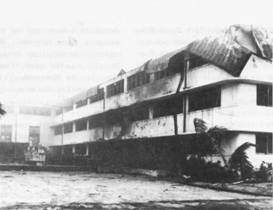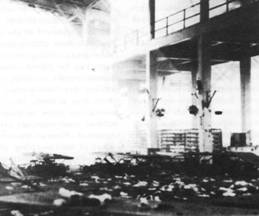The Attack
S1c Cleveland Dodge
Working in a battleship's magazine was not an easy job.Munitions had to be stowed and retrieved carefully; a stray spark of static electricity might destroy enough of the ship to sink it.Gunpowder was stored below the waterline; in the event of a fire above, the powder rooms would be flooded immediately, likely drowning those who served there.When the guns were firing, ammunition (and also, for the big guns, canisters of powder) had to be loaded, quickly and without accident, into hoists, and then transported to the guns above.
When the attack began, the California 's Lt. Commander (the ranking officer then on board) ordered its crew to their battle stations.He then had the boiler room start building up steam for the ship's turbo-electric engines, intending to move the battleship into the open sea, where it could draw the attack away from Pearl Harbor , and from where he might launch a long-distance counter-attack against the Japanese.The limited supply of on-hand ammunition soon ran out; the rest was locked in the magazines.To get more, crewmen had to run down to the lower decks and gain access to the magazines.
Meanwhile, torpedo bombers were targeting the ship, and one torpedo struck home.Normally, the resulting flood of incoming water might have been staunched, but an inspection had been scheduled for that morning, and many watertight doors stood wide open.The water spread quickly through the hull.Next, bombs fell from above and hit the ship, killing scores of the crew and igniting a fire.Although the fire was ultimately extinguished, the ship lost power, rendering it indefensible, and it was abandoned.It sank slowly, coming to rest on the mud beneath Pearl 's shallow waters, so that it listed to port.

As ships and oil burn on the water,
U.S.S. California settles on Pearl Harbor 's bottom.
Naval History and Heritage Command
https://www.history.navy.mil/
PFC John Haughey
On Saturday night, Haughey had fallen asleep in his bed in Hickam Field's barracks.By 8:00 AM Sunday, a number of soldiers had gone to breakfast in the mess hall.Some early birds were back already, getting ready for their day, and Saturday's night owls were still trying to sleep late.The sound of gunfire - at first, it sounded like artillery practice - annoyed them.
People looked out the windows as a dive bomber dropped its payload on the Air Depot Building .Not yet comprehending what they saw, they watched the airplane level off and fly towards the barracks.As it passed overhead, they could see the large red disks painted on its wings.Only then did they understand.
Before they could react, bombs were exploding in the hangars next door.Then more bombs pierced the roof overhead and penetrated the barracks.Explosions sent beds, equipment, shards of window glass, and bodies through the air.Men ran down the stairs and out to the lawn, where they met comrades who had fled the mess hall.Not knowing where to go, those who remained in the open were strafed (i.e., machine-gunned by planes flying low overhead).Those who still could flee did, scattering anywhere and everywhere.
|
|
|
|
Consolidated Barracks (post-attack) |
Mess Hall (post-attack) |
|
7 December 1941: The Air Force Story, Chapter V |
|
***



